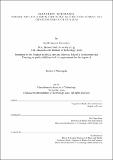| dc.contributor.advisor | Pattie Maes. | en_US |
| dc.contributor.author | Amores Fernandez, Judith. | en_US |
| dc.contributor.other | Program in Media Arts and Sciences (Massachusetts Institute of Technology) | en_US |
| dc.date.accessioned | 2021-01-06T20:18:28Z | |
| dc.date.available | 2021-01-06T20:18:28Z | |
| dc.date.copyright | 2020 | en_US |
| dc.date.issued | 2020 | en_US |
| dc.identifier.uri | https://hdl.handle.net/1721.1/129318 | |
| dc.description | Thesis: Ph. D., Massachusetts Institute of Technology, School of Architecture and Planning, Program in Media Arts and Sciences, September, 2020 | en_US |
| dc.description | Cataloged from student-submitted PDF of thesis. | en_US |
| dc.description | Includes bibliographical references (pages 157-180). | en_US |
| dc.description.abstract | Human-computer interaction has traditionally focused on interfaces that provide explicit visual, auditory, or haptic feedback. This thesis proposes a new type of user interface that uses scent as an implicit, less conscious output that influences the person's cognition and pairs it with implicit physiological information as the input to the system. Unlike other modalities such as sound or light, olfactory stimuli presented during sleep are less likely to awaken the user, and, during the daytime they can be subtle enough not to distract the user from their primary activity. Therefore, scent offers a unique opportunity to create novel interfaces and applications that extend from wake to sleep states. This thesis provides a framework that conceptualizes how these type of liminal interfaces fit within the broader field of HCI. | en_US |
| dc.description.abstract | It posits that a continuum of possible human-computer interactions exists as the combination of 1) Implicit and Explicit inputs from the human to the computer, 2) Explicit or Implicit outputs from the machine to the human and 3) the level of consciousness of the user (such as during sleep). The dissertation exemplifies this framework with closed-loop olfactory interfaces that provide scent-feedback based on real-time user information during wakefulness and sleep. This research necessitated the development of new wearables, concepts, software, and designs that considerably improve on state of the art olfactometers. Current scent technologies used in sleep laboratories are not portable and require the use of nasal masks, large olfactometers, and a minimum of 22 wire attachments to track physiological information. As a result, they are not suitable for mobile, daytime applications, nor for home usage by non-expert users. | en_US |
| dc.description.abstract | In contrast, the prototypes created for this thesis allow for wearable scent delivery and have been used by non-expert users in home settings during day and night. These devices have been validated through a series of user studies that show the usability of the prototypes and their significant effect on relaxation, sleep, and memory consolidation. This thesis presents the qualitative and quantitative results obtained in these studies using subjective reports and physiological monitoring. | en_US |
| dc.description.statementofresponsibility | by Judith Amores Fernandez. | en_US |
| dc.format.extent | 180 pages | en_US |
| dc.language.iso | eng | en_US |
| dc.publisher | Massachusetts Institute of Technology | en_US |
| dc.rights | MIT theses may be protected by copyright. Please reuse MIT thesis content according to the MIT Libraries Permissions Policy, which is available through the URL provided. | en_US |
| dc.rights.uri | http://dspace.mit.edu/handle/1721.1/7582 | en_US |
| dc.subject | Program in Media Arts and Sciences | en_US |
| dc.title | Olfactory interfaces : toward implicit human-computer interaction across the consciousness continuum | en_US |
| dc.title.alternative | Toward implicit human-computer interaction across the consciousness continuum | en_US |
| dc.type | Thesis | en_US |
| dc.description.degree | Ph. D. | en_US |
| dc.contributor.department | Program in Media Arts and Sciences (Massachusetts Institute of Technology) | en_US |
| dc.identifier.oclc | 1227782732 | en_US |
| dc.description.collection | Ph.D. Massachusetts Institute of Technology, School of Architecture and Planning, Program in Media Arts and Sciences | en_US |
| dspace.imported | 2021-01-06T20:18:27Z | en_US |
| mit.thesis.degree | Doctoral | en_US |
| mit.thesis.department | Media | en_US |
